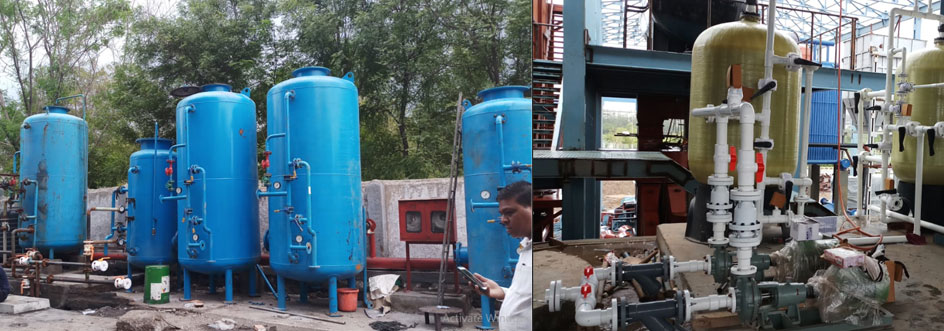D.M. Plant
A demineralizer is a system, which uses ion exchange chemical process to remove dissolved ionic compounds (salts) from water. It is also known as Deionized Water System, Demineralizer or DM Plant. A typical Demineralization Plant (DM Plant) consists of two vessels. The feed water or raw water is passed through first vessel i.e. containing strong base cation resin in the form of Hydrogen (H+), whereupon all the positively charged ions (sodium, calcium, iron and copper etc.) are exchanged for Hydrogen ions; after that, the water further passed through another vessel containing strong base anion resin in the form of Hyudroxyl (OH-), whereupon all the negatively charged ions (chloride, sulphate, nitrate, etc) are exchanged for hydroxide ions which then combine with the hydrogen ions to form water.
Types of Demineralizers
- Two Bed Demineralizer
- Mixed Bed Demineralizer
Two Bed Demineralizer
The two-bed deionizer consists of two vessels - one containing a Cation-exchange resin in the hydrogen(H+) form and the other containing an anion resin in the hydroxyl (OH-) form. Water flows through the caution column, whereupon all the captions are exchanged for hydrogen ions. To keep the water electrically belanced, for every monovalent Caution, e.g. Na+, one hydrogen ion is exchanged and for every divalent caution, e.g. Ca2+ , or Mg2+, two hydrogen ions are exchanged. The same principle applies when considering anion exchange. The desalinized water then flows through the anion column. This time all the negatively changed ions are exchanged for hydroxide ions which then combine with the hydrogen ions to form water (H2O).
Mixed Bed Demineralizer
In mixed-bed deionizers the caution-exchange and anion-exchange resins are intimately mixed and contained in a single pressure vessel. The thorough mixture of Caution-exchangers and anion-exchangers in a single column makes a mixed-bed deionizer equivalent to a lengthy series of two-bed plants. As a result, the water quality obtained from a mixed-bed deionizer is appreciably higher than that produced by a two-bed plant.
Although more efficient in purifying the incoming feed water, mixed-bed plants are more sensitive to impurities in the water Supply and involve a more complicated regeneration process. Mixed-bed deionizers are normally used to 'polish' the Water to higher levels of purity after it has been initially treated by either a two-bed deionizer or a reverse osmosis unit. Demineralizer Applications
- Paint Factory
- Printing
- Chemical Processing
- Glassware rinse
- Textiles Mills
- Plating
- Electro deposition
- Cosmetics Production

